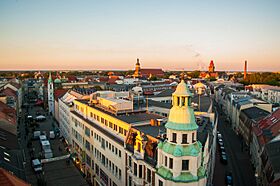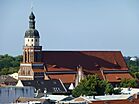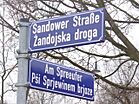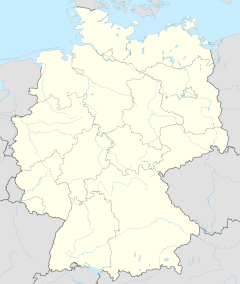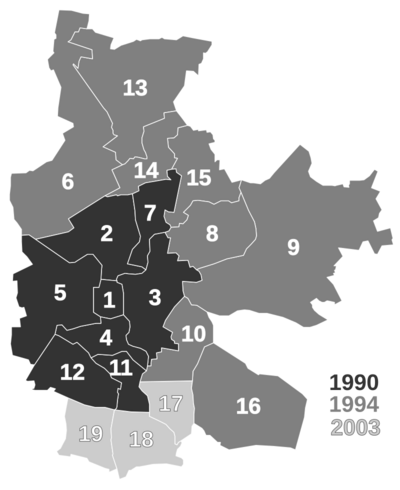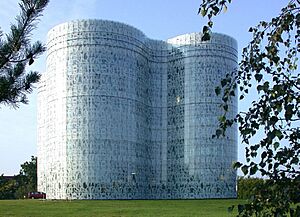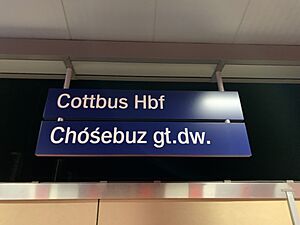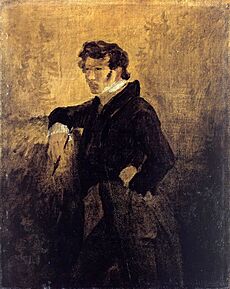Cottbus facts for kids
Quick facts for kids
Cottbus
Chóśebuz
|
|||
|---|---|---|---|
|
From top: View of Cottbus at sunset,
Cottbus State Theater – Statne źiwadło Chóśebuz Old Market Square – Stare wiki St Nicholas' Church – Cerkwja swěteho Mikławša bilingual Cottbus street signage Prince Pückler Park Branitz Branitz Castle – Grod Rogeńc Old Market Square at night |
|||
|
|||
| Country | Germany | ||
| State | Brandenburg | ||
| District | Urban district | ||
| Area | |||
| • Total | 164.28 km2 (63.43 sq mi) | ||
| Elevation | 70 m (230 ft) | ||
| Population
(2022-12-31)
|
|||
| • Total | 99,515 | ||
| • Density | 605.765/km2 (1,568.92/sq mi) | ||
| Time zone | UTC+01:00 (CET) | ||
| • Summer (DST) | UTC+02:00 (CEST) | ||
| Postal codes |
03042-03055
|
||
| Dialling codes | 0355 | ||
| Vehicle registration | CB | ||
| Website | www.cottbus.de | ||
Cottbus (also called Chóśebuz in Lower Sorbian) is a city in Germany. It's a university city and the second-largest city in the state of Brandenburg. About 98,000 people live here, making it the biggest city in the Lusatia region.
Cottbus is located in an area where the Sorbs (also known as Wends) live. It's the second-largest city on the River Spree after Berlin. The city is also next to Cottbus Eastern Lake, which will become Germany's largest artificial lake when it's completely filled with water.
Cottbus is a very important place for the Lower Sorbian-speaking Sorbs. It's the biggest city in Germany where two languages are commonly used. You'll often see signs in both German and Lower Sorbian. The city is home to several Sorbian places, like the Sorbian Broadcasting station, the Lower Sorbian High School, and the Wendish Museum.
In the 10th century, the Wends built a large Slavic castle on an island in the Spree River. This old castle is where the city first started. Today, you can still see the big 13th-century Castle Tower with its blue clock.
Cottbus is also home to the Brandenburg University of Technology. Because of this, the city is officially called 'University City Cottbus'. Branitz Castle, built in 1770–71, is in the southeast of the city. It was once the home of Prince Pückler-Muskau, who also designed the beautiful Muskau Park. He created the large Branitz Park with its two grass pyramids. One of these pyramids is in the middle of a lake! The Cottbus State Theater is the only state theater in Brandenburg. The Wendish Quarter is a part of the city designed to look like traditional Sorbian buildings.
Contents
City Name and Languages
The name of the city, Cottbus, has been spelled differently over time. In Berlin, some people used to prefer "Kottbus," which is why you might see "Kottbusser Tor" (Cottbus Gate) there. However, in Cottbus itself, the traditional spelling "Cottbus" is used most of the time.
Cottbus is a special place because it's bilingual. This means two languages are used: German and Lower Sorbian. You'll see signs in both languages, and there are schools and museums that focus on the Sorbian language and culture.
Here are the names of Cottbus in different languages:
- Czech: Chotěbuz (Czech)
- German: Cottbus (German)
- Latin: Cotbusium (Latin)
- Polish: Chociebuż (Polish)
- Lower Sorbian: Chóśebuz (Lower Sorbian)
- Upper Sorbian: Choćebuz (Upper Sorbian)
- Yiddish: קוטבוס (Yiddish)
History of Cottbus
Cottbus began in the 10th century when the Sorbs built a castle on a sandy island in the Spree River. In 965, the area was taken by the March of Lusatia. It then became part of Poland in 1002, but returned to Lusatia in 1032. The first time the town's name was written down was in 1156. In the 13th century, German settlers arrived and lived alongside the Sorbs.
During the Middle Ages, Cottbus was famous for its wool. The town's wool products were sold all over Brandenburg, Bohemia, and Saxony. Cottbus was also on an important trade route called the "Salt Road." This road was used to carry salt from Halle to Lusatia and further east into Poland.
Over the centuries, Cottbus was part of different kingdoms and states. It was part of the Bohemian Crown until 1445, when it became part of Brandenburg. In 1701, Brandenburg became the Kingdom of Prussia.
In 1807, after a war, Cottbus was given to the Kingdom of Saxony. But in 1815, after the Napoleonic wars, it was returned to Prussia. Cottbus remained part of Prussia until 1947. In the 19th century, the Sorbian newspaper Bramborski Serbski Casnik was published in the city. Also, in 1880, the first Lower Lusatian branch of the Maćica Serbska organization, which supports Sorbian culture, was started here.
In 1871, Cottbus became part of the new German Empire. In 1905, most of the people living in Cottbus were Germans, with a smaller number of Sorbs and Poles.
During World War II, Cottbus was taken by the Red Army on April 22, 1945. After the war, from 1949 until Germany was reunited in 1990, Cottbus was part of East Germany.
City Parts
Cottbus is divided into several areas, each with its own name. Many of these areas also have a Lower Sorbian name. Here's a look at some of them:
| German Name | Lower Sorbian Name | People Living There | Area (km2) | |
|---|---|---|---|---|
| 1 | Mitte | Srjejź | 10,732 | 1.7 |
| 2 | Schmellwitz | Chmjelow | 14,116 | 8.1 |
| 3 | Sandow | Žandow | 15,301 | 8.7 |
| 4 | Spremberger Vorstadt | Grodkojske pśedměsto | 13,800 | 3.6 |
| 5 | Ströbitz | Strobice | 15,726 | 11.7 |
| 6 | Sielow | Žylow | 3,510 | 18.8 |
| 7 | Saspow | Zaspy | 686 | 4.3 |
| 8 | Merzdorf | Žylowk | 1,089 | 7.4 |
| 9 | Dissenchen | Dešank | 1,101 | 30.7 |
| 10 | Branitz | Rogeńc | 1,446 | 5.4 |
| 11 | Madlow | Módłej | 1,630 | 3.0 |
| 12 | Sachsendorf | Knorawa | 10,584 | 6.6 |
| 13 | Döbbrick | Depsk | 1,695 | 15.5 |
| 14 | Skadow | Škódow | 568 | 4.6 |
| 15 | Willmersdorf | Rogozno | 633 | 6.4 |
| 16 | Kahren | Kórjeń | 1,259 | 14.0 |
| 17 | Kiekebusch | Kibuš | 1,292 | 3.7 |
| 18 | Gallinchen | Gołynk | 2,768 | 5.5 |
| 19 | Groß Gaglow | Gogolow | 1,487 | 4.6 |
| Cottbus | Chóśebuz | 99,423 | 164.3 |
Population Changes
| Cottbus: How the Population Has Changed (since 1875) | ||||||||||||||||||||||||||||||||||||||||||||||||||||||||||||||||||||||||||||||||||||||||||||||||||||||||||||||||||||||||||||||||||||||||||||||||||
|---|---|---|---|---|---|---|---|---|---|---|---|---|---|---|---|---|---|---|---|---|---|---|---|---|---|---|---|---|---|---|---|---|---|---|---|---|---|---|---|---|---|---|---|---|---|---|---|---|---|---|---|---|---|---|---|---|---|---|---|---|---|---|---|---|---|---|---|---|---|---|---|---|---|---|---|---|---|---|---|---|---|---|---|---|---|---|---|---|---|---|---|---|---|---|---|---|---|---|---|---|---|---|---|---|---|---|---|---|---|---|---|---|---|---|---|---|---|---|---|---|---|---|---|---|---|---|---|---|---|---|---|---|---|---|---|---|---|---|---|---|---|---|---|---|---|---|
|
|
|
||||||||||||||||||||||||||||||||||||||||||||||||||||||||||||||||||||||||||||||||||||||||||||||||||||||||||||||||||||||||||||||||||||||||||||||||
Climate
Cottbus has a mild climate, even though it's far from the ocean. Summers are quite warm, and winters are usually mild. This is because of winds from the Atlantic Ocean. However, sometimes very cold weather can happen when winds come from other directions. It rains often, but usually not very heavily. Snow falls regularly, but it often melts quickly.
| Climate data for Cottbus (1991–2020 normals, extremes since 1900) | |||||||||||||
|---|---|---|---|---|---|---|---|---|---|---|---|---|---|
| Month | Jan | Feb | Mar | Apr | May | Jun | Jul | Aug | Sep | Oct | Nov | Dec | Year |
| Record high °C (°F) | 16.6 (61.9) |
20.6 (69.1) |
25.4 (77.7) |
31.2 (88.2) |
33.3 (91.9) |
39.2 (102.6) |
38.9 (102.0) |
38.5 (101.3) |
34.5 (94.1) |
29.2 (84.6) |
20.2 (68.4) |
17.9 (64.2) |
39.2 (102.6) |
| Mean maximum °C (°F) | 11.4 (52.5) |
13.2 (55.8) |
19.0 (66.2) |
25.2 (77.4) |
29.1 (84.4) |
32.4 (90.3) |
33.6 (92.5) |
33.4 (92.1) |
27.9 (82.2) |
22.6 (72.7) |
16.0 (60.8) |
11.6 (52.9) |
35.5 (95.9) |
| Mean daily maximum °C (°F) | 3.5 (38.3) |
5.3 (41.5) |
9.4 (48.9) |
15.7 (60.3) |
20.3 (68.5) |
23.6 (74.5) |
25.6 (78.1) |
25.4 (77.7) |
20.3 (68.5) |
14.4 (57.9) |
8.2 (46.8) |
4.4 (39.9) |
14.7 (58.5) |
| Daily mean °C (°F) | 0.8 (33.4) |
1.7 (35.1) |
4.8 (40.6) |
10.0 (50.0) |
14.5 (58.1) |
17.9 (64.2) |
19.8 (67.6) |
19.3 (66.7) |
14.6 (58.3) |
9.8 (49.6) |
5.1 (41.2) |
1.9 (35.4) |
10.0 (50.0) |
| Mean daily minimum °C (°F) | −2.1 (28.2) |
−1.7 (28.9) |
0.4 (32.7) |
3.9 (39.0) |
8.2 (46.8) |
11.8 (53.2) |
13.8 (56.8) |
13.4 (56.1) |
9.4 (48.9) |
5.5 (41.9) |
1.9 (35.4) |
−0.7 (30.7) |
5.3 (41.5) |
| Mean minimum °C (°F) | −12.8 (9.0) |
−9.9 (14.2) |
−6.7 (19.9) |
−3.1 (26.4) |
1.5 (34.7) |
5.7 (42.3) |
8.2 (46.8) |
7.5 (45.5) |
3.0 (37.4) |
−2.1 (28.2) |
−5.6 (21.9) |
−9.3 (15.3) |
−14.8 (5.4) |
| Record low °C (°F) | −26.6 (−15.9) |
−29.5 (−21.1) |
−23.0 (−9.4) |
−14.2 (6.4) |
−3.5 (25.7) |
−1.9 (28.6) |
4.3 (39.7) |
3.2 (37.8) |
−2.7 (27.1) |
−10.2 (13.6) |
−14.4 (6.1) |
−25.8 (−14.4) |
−29.5 (−21.1) |
| Average precipitation mm (inches) | 41.5 (1.63) |
34.1 (1.34) |
40.9 (1.61) |
30.6 (1.20) |
56.6 (2.23) |
53.1 (2.09) |
74.8 (2.94) |
63.0 (2.48) |
46.3 (1.82) |
40.5 (1.59) |
42.9 (1.69) |
42.0 (1.65) |
566.0 (22.28) |
| Average precipitation days (≥ 0.1 mm) | 17.5 | 14.5 | 15.0 | 11.6 | 13.1 | 12.3 | 13.6 | 12.9 | 11.8 | 13.7 | 14.6 | 16.4 | 167.0 |
| Average relative humidity (%) | 83.4 | 79.7 | 75.0 | 66.5 | 66.4 | 66.2 | 67.0 | 68.8 | 76.2 | 81.1 | 85.1 | 84.7 | 75.0 |
| Mean monthly sunshine hours | 54.0 | 77.1 | 127.1 | 192.4 | 227.3 | 228.0 | 237.2 | 227.4 | 169.0 | 118.9 | 62.7 | 49.1 | 1,770.3 |
| Source 1: NOAA | |||||||||||||
| Source 2: Infoclimat | |||||||||||||
Culture and Education
Cottbus is a major center for the Lower Sorbian people. Many signs in the city are in both German and Lower Sorbian. There's even a special high school, called a Gymnasium, where classes are taught in Lower Sorbian. There's also a Sorbian Quarter, which is a part of the city designed to show Sorbian culture.
Near Cottbus, you can find the famous Branitz Park. This beautiful park was created by Prince Hermann von Pückler-Muskau after 1845. Inside the park is Schloss Branitz (Branitz Castle), which was rebuilt between 1846 and 1852. The gardens have two unique pyramids. One of them, the Seepyramide (Lake Pyramid), is in the middle of an artificial lake and is where the prince is buried.
Cottbus is also home to the Brandenburg University of Technology (BTU). There's also a special high school focused on math and science, called the Max-Steenbeck-Gymnasium.
Every year, Cottbus hosts the East Europe International Film Festival, which is a big event for movie lovers.
If you like sports, Cottbus has a football team called Energie Cottbus. They play their home games at the Stadion der Freundschaft.
Economy and Transportation
Getting Around Cottbus
Cottbus has a main railway station called Cottbus Hauptbahnhof. This is a central point for train travel.
There are also two smaller airports near the city: Cottbus-Drewitz Airport and Cottbus-Neuhausen Airport. For bigger flights, Berlin Brandenburg Airport is only about an hour away by car or train.
Within the city, you can get around using trams and buses. These are run by local transport companies.
Power and Energy
Around Cottbus, there are several large power stations that burn lignite, a type of coal. This lignite is dug up from big open-pit mines nearby. Some of these mines have been closed down. For example, the former Cottbus-Nord mine is now being turned into a huge artificial lake called Cottbuser Ostsee (Cottbus Eastern Lake).
City Government
Mayor and City Council
The current mayor of Cottbus is Tobias Schick from the Social Democratic Party (SPD). He became mayor in 2022.
The city council works with the mayor to run the city. People in Cottbus vote for members of the city council to represent them. The most recent city council election was held in June 2024.
Sister Cities
Cottbus has "sister city" relationships with several cities around the world. This means they share cultural and educational exchanges.
 Montreuil, France (since 1959)
Montreuil, France (since 1959) Grosseto, Italy (since 1967)
Grosseto, Italy (since 1967) Lipetsk, Russia (since 1974)
Lipetsk, Russia (since 1974) Zielona Góra, Poland (since 1975)
Zielona Góra, Poland (since 1975) Targovishte, Bulgaria (since 1975)
Targovishte, Bulgaria (since 1975) Košice, Slovakia (since 1978)
Košice, Slovakia (since 1978) Saarbrücken, Germany (since 1987)
Saarbrücken, Germany (since 1987) Gelsenkirchen, Germany (since 1995)
Gelsenkirchen, Germany (since 1995) Nuneaton and Bedworth, England, United Kingdom (since 1999)
Nuneaton and Bedworth, England, United Kingdom (since 1999)
Famous People from Cottbus
Many notable people were born or lived in Cottbus, including:
- Janice Behrendt (born 1983), a beauty queen and model
- Carl Blechen (1798–1840), a famous landscape painter
- Rudi Fink (born 1958), an amateur boxer and coach
- Robert Harting (born 1984), a discus thrower
- Tony Martin (born 1985), a professional cyclist
- Reinhold Platz (1886–1966), an aircraft designer
- Gabriele Reinsch (born 1963), a world record holder in discus throwing
See also
 In Spanish: Cottbus para niños
In Spanish: Cottbus para niños


